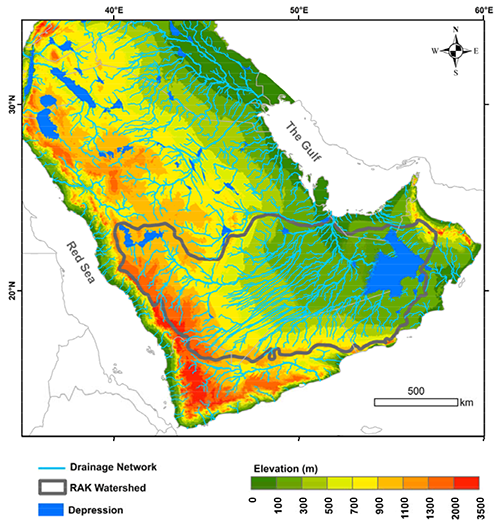Many of the driest deserts in the world sit on top of enormous groundwater deposits, but limited annual precipitation means that these ancient aquifers are not being adequately recharged. A new study using multiple lines of evidence to map the Mega Aquifer System under the Arabian Peninsula is shedding some light on how arid regions can tap into their groundwater reserves without depleting their limited resources.
The Mega Aquifer System (MAS) is one of the largest aquifer systems in the world, underlying the extreme deserts of the Arabian Peninsula and crossing borders between Saudi Arabia, Iraq, Jordan, Oman, Yemen, and the United Arab Emirates. “The existence of this aquifer system has been known for some time, but so far there’s a vacuum of published information about it,” said Neil Sturchio, a geochemist at the University of Delaware in Newark and an author of the new study.
Currently, Saudi Arabia, the largest and most developed nation on the Arabian Peninsula, sources most of its drinking water by desalinating seawater, but using that water for agriculture “is cost prohibitive,” Sturchio said. “As the population of Saudi Arabia grows, the Saudi government has sought to develop its groundwater resources to support more irrigation for agriculture.”
Modeling, Mapping, Remote Sensing
To gain a deeper understanding of the MAS, lead author Mohamed Sultan of Western Michigan University in Kalamazoo and colleagues sought to characterize the aquifer’s age, origin, and hydrogeological setting using a combination of computer models, field mapping, and geochemical and isotopic testing, as well as remote sensing methods.
Determining the age of the water in the aquifer—meaning how long ago the water was deposited into the subsurface—is crucial for understanding where the water comes from and how it moves underground. Because the Arabian Peninsula is so dry, with more than half the region receiving less than 25 millimeters of rain a year, much of the water in the MAS is considered fossil water. Some of the water dates as far back as the Pleistocene, when a wetter climate filled up many of the world’s aquifers. Other regions, such as the southern mountainous areas of the Arabian Peninsula, see more annual rain and snow, which continuously recharges the aquifer.

By using the radioactive isotopes carbon-14 and chlorine-36, the team was able to trace the ancient and modern origins of MAS groundwater, as well as map out its flow paths and residence times. Those data were then plugged into numerical flow models that show an overall west to east drainage trend across the Arabian Peninsula as water flows east out of the higher, wetter Red Sea Hills into the older, saltier eastern desert regions.
“With a large system like this, the more lines of evidence we have, the clearer the picture gets,” Sturchio said.
The team then turned to data gathered by the Gravity Recovery and Climate Experiment (GRACE) satellite mission, a collaboration between NASA and the German Aerospace Center. Between 2002 and 2017, GRACE mapped variations in Earth’s gravity field.
“Most of the changes in gravity measurements come from the addition or subtraction of water from either surface or groundwater reserves,” Sturchio said. By combining these measurements with satellite-based precipitation data and field investigations, the team was able to map out where the MAS is being depleted at rates faster than it is being recharged.
Documenting Decreasing Groundwater
“It’s pretty clear from these data that over the last 10 to 15 years groundwater levels have been decreasing across some regions of the Arabian Peninsula,” Sturchio said. The depletion is due to pumping of groundwater for irrigation in the central and northern sections of the MAS, which receive little annual recharge from precipitation. The more mountainous southern regions of the MAS may be more suitable for intensive agricultural development, especially if water-intensive crops such as wheat and alfalfa are replaced by more drought-tolerant potatoes and sugar beets.
“This study offers an impressive combination of remote sensing, land surface models, geochemistry, and field observations in a nice package,” said Tom Gleeson, a hydrogeologist at the University of Victoria in British Columbia who was not involved in the new study.
As countries seek to develop their groundwater reserves, more such studies will be needed if such development is going to be sustainable, Gleeson said. For every aquifer, “there is a definable maximum rate at which you can pump water out of the ground without depleting it irreversibly.”
Multipronged studies such as the new Journal of Hydrology paper can help quantify sustainable extraction rates, Gleeson said, especially because the majority of the planet’s large aquifers contain fossil water that is not being continuously recharged.
Going forward, a broader understanding of how large fossil aquifer systems work, combined with closer monitoring of individual systems like the MAS, will be crucial to maintaining global groundwater reserves, Gleeson said. “It’s important to define what it means to be sustainable. For it to be truly sustainable, we shouldn’t see decreasing water levels in subsurface groundwater.”
—Mary Caperton Morton (@theblondecoyote), Science Writer






